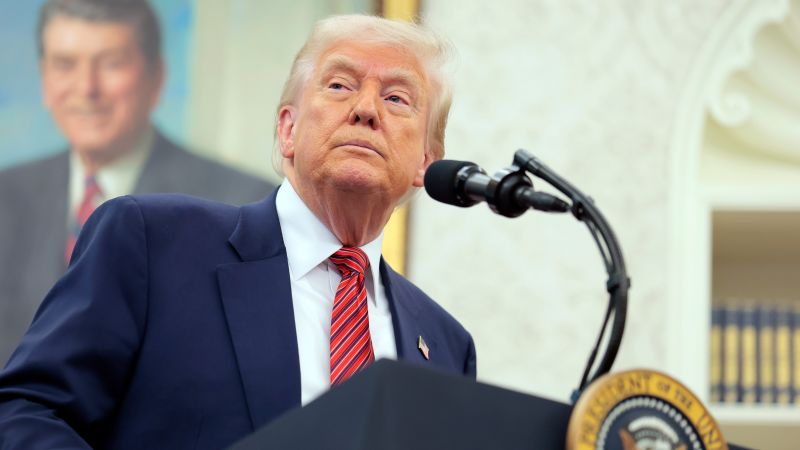In recent weeks, President Donald Trump has recorded notable successes in the U.S. economy, despite ongoing concerns surrounding the impacts of the trade war. Unemployment rates remain stable and inflation continues to decline—a juxtaposition that has led some analysts to predict a potential economic boom for the U.S. during the current quarter. However, the presidency is equally marked by simmering tensions with China, as Trump’s increasingly antagonistic discourse adds a layer of uncertainty to the nation’s economic landscape.
The significant date of May 12 marked a pivotal shift in the protracted global trade conflict. That day, officials from both China and the United States released statements indicating a mutual intention to significantly reduce the historically elevated tariffs imposed on one another. This news was met with excitement on Wall Street, where banks promptly adjusted their recession predictions and consumer confidence witnessed a sharp rebound—showing signs of improvement after a dampened previous month when trade interactions had virtually stalled due to escalated tariffs.
In April, trade dynamics between the two nations were strained, exemplified by the 145% tariffs restricting American businesses from importing goods from China, which is the United States’ second-largest trading partner. Treasury Secretary Scott Bessent, who plays a crucial role in negotiations with China, asserted that previous tariff levels were “unsustainable,” emphasizing that mechanisms are now in place to prevent a return to those troubled times.
Despite the diplomatic thaw in relations suggested by earlier tariff reductions, recent weeks have seen a resurgence in hostile rhetoric from Trump, as he accused China of breaching agreements made during negotiations. Conversely, China has countered these accusations, claiming that the U.S. has not fulfilled its obligations within the trade deal framework. This cycle of recriminations raises the risk of renewed tensions as the two countries navigate this fraught diplomatic landscape.
A telephone call between Trump and Chinese leader Xi Jinping was anticipated following the diplomatic tensions. Failure from this engagement to yield constructive outcomes could trigger not only increased tariffs but also renewed recession forecasts. Such an outcome would undermine the recent economic gains and joyful market movements that have followed optimistic economic data releases.
While economic reports can often present mixed findings, some recent data has been surprisingly strong. For instance, annual consumer prices climbed a modest 2.3% in April according to the Consumer Price Index, and inflation fell to 2.1% in the same month according to the Personal Consumption Expenditures price index, a crucial gauge favored by the Federal Reserve. This data indicates that the economy is drifting closer to the Fed’s long-term target of 2% inflation, suggesting potential stabilization after previous volatile inflation rates.
Despite this positive economic backdrop, Trump has been vocally pressing Federal Reserve Chair Jerome Powell to consider cutting interest rates to stimulate the economy further. In recent months, while jobs numbers have been softening, overall employment growth has remained relatively stable, with the unemployment rate hovering just above 4%. Unexpectedly, the number of available jobs in the U.S. increased in April, suggesting a resilient labor market.
Interestingly, current trade tensions may temporarily benefit the U.S. economy. Following declines in the first quarter due to pre-tariff inventory stockpiling, imports from abroad, particularly from China, have dropped. Observably, the U.S. trade deficit narrowed at an unprecedented rate in April, a shrinkage that should provide a momentary boost to economic growth.
However, while the Atlanta Fed’s GDPNow tool anticipates a staggering growth rate of 4.6% for this quarter, there is still caution regarding Trump’s renewed pressure on Beijing. His statements reflecting frustration with Chinese methodologies risk jeopardizing burgeoning economic progress, especially as trade talks have reached a standstill.
Trump recently described Xi Jinping as “extremely hard to make a deal with,” illustrating the complexity of the ongoing discussions, which have prompted him to assert that China has totally violated its agreements while expressing dissatisfaction with their handling of rare earth materials—critical to technology production.
Furthermore, U.S. trade restrictions have ramped up regarding Chinese businesses and products, including warnings to companies about dealings with China’s tech giant Huawei and limitations on software transfers essential for semiconductor design. This evolving landscape displays the precariousness of U.S.-China relations, particularly as accusations fly both ways.
Moreover, higher tariffs remain in effect, contributing to significant economic anxiety among economists and business leaders who are concerned about how rising prices may coincide with slower economic growth. Recent economic reports reveal worrying signs, including a notable uptick in layoffs and initial unemployment claims, signaling economic fragility that challenges the otherwise positive outlook.
As consumer spending displays signs of weakness and sentiment remains low, the possibility exists that economic optimism may evaporate dramatically should tensions between the U.S. and China worsen further. The intricate interplay of domestic economic data, international trade policies, and the resolving geopolitical conflicts will continue to shape the presentation of U.S. economic health and public perceptions in the coming months.



